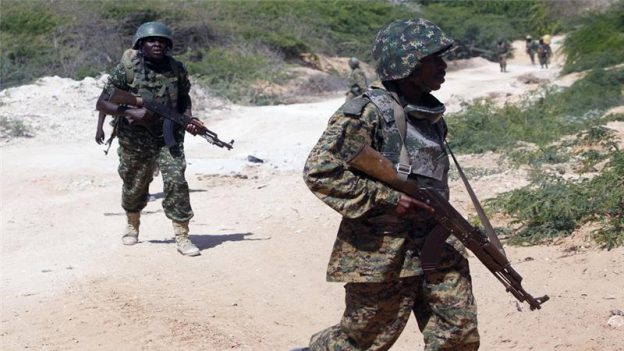
26th July 2024 admin Category :
By PATRICK GATHARA
Oct. 14, 2016
(The Star) This Sunday marks the fifth anniversary of the start of Operation Linda Nchi, Kenya’s surprise invasion of Somalia. By the government’s own admission, the October 2011 deployment of the Kenya Defence Forces across the porous border had been long in the planning. A spate of kidnappings of tourists and aid workers in the preceding months by armed gangs based in Somalia, which the state subsequently blamed on the al Shabaab terror group and which laid waste to the lucrative tourism industry, provided the pretext to launch the first ever major cross-border military operation in the country’s history.
Five years since that fateful decision, and with the Kenyan forces now ensconced within the African Union Mission in Somalia, there has been little public discussion of the wisdom of the incursion and even less of whether the operation achieved its stated objectives.
The Government of Kenya had invoked Article 51 of the United Nations Charter, which recognises member nations’ right to self-defence as a justification for its actions. And while no one would dispute Kenya was indeed threatened, the lingering question was whether sending troops into Somalia was the best way to guarantee domestic safety. In the short term at least, the decision to invade appears to have backfired spectacularly.
Rather than reducing attacks on the homeland, the invasion appears to have opened the floodgates. In the four years following Operation Linda Nchi, terrorist attacks went up nine-fold, compared to the four years preceding it. They increased, not just in number, but in ferocity as well. Three of the four worst attacks, in terms of lives lost, happened after the Somalia invasion. And, consistently, the invasion itself was cited as justification for the atrocities.
Neither has the invasion proven particularly decisive in helping to restore order in war-torn Somalia. The government in Mogadishu is as unpopular, riven and ineffectual as ever. Popular elections remain a dream and the Somali National Army, which Amisom is meant to be training up, resembles little more more than a hodge-podge of disparate clan militias than the unified, professional military it needs to be. The security situation continues to be dire with al Shabaab in control of vast swathes of the Somali countryside, from where it is able to plan and launch devastating attacks in their country and in Kenya.
Nearly a year after the invasion, the Kenyan contingent, now at least nominally directed by the Amisom Force Commander in Mogadishu rather than the the Ministry of Defence in Nairobi, rolled into the strategic al Shabaab stronghold in the seaport of Kismayo, to date its most significant achievement. But even this did not turn out to be the fatal blow many had predicted.
Allegations soon surfaced of the KDF engaging in the illegal export of charcoal through the port, a trade that directly benefitted the terror group they were supposed to be fighting. A report by the UN Montoring Group indicated the militants were actually making more money after the KDF took over the port.
If anything, the legacy of the operation has been felt much more within Kenya than across the border. As the al Shabaab have mercilessly exploited Kenya’s vulnerabilities and exposed security and intelligence failures, “national security” has become a catch-all phrase for the government to avoid accountability. By providing justification for continued attacks on Kenya as well as a cover for government to hide its malfeasance and incompetence, Operation Linda Nchi did little to live up to its billing. On that score alone, it must be considered a failure.







